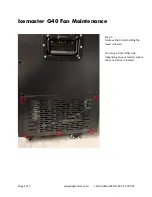
9
ITALIANO
ENGLISH
10) Le etichette con le istruzioni, applicate sulla zappatrice, danno gli opportuni consigli in forma
essenziale per evitare gli infortuni.
11) Per la circolazione su strada, è necessario attenersi alle normative del codice stradale in vigore
nel relativo Paese.
12) Rispettare il peso massimo previsto sull'asse del trattore, il peso totale mobile, la regolamentazione
sul trasporto e il codice stradale.
13) Prima di iniziare il lavoro, familiariz-zare con i dispositivi di comando e le loro funzioni.
14) Usare un abbigliamento idoneo. Evitare assolutamente abiti svolazzanti o con lembi che in
qualche modo potrebbero impigliarsi in parti rotanti e in organi in movimento.
15) Agganciare la zappatrice, come previsto, su di un trattore di adeguata potenza e configurazione
mediante l'apposito dispositivo (sollevatore), conforme alle norme.
16) Prestare la massima attenzione nella fase di aggancio e sgancio della zappatrice.
17) Gli eventuali accessori per il trasporto devono essere muniti di segnalazioni e protezioni
adeguate.
18) Con trattore in moto, non lasciare mai il posto di guida.
19) È molto importante tenere presente che la tenuta di strada e la capacità di direzione e frenatura,
possono essere influenzati, anche in modo notevole, dalla presenza di una zappatrice portata o
trainata.
20) In curva, fare attenzione alla forza centrifuga esercitata in posizione diversa, del centro di gravità,
con e senza la zappatrice portata.
21) Prima di inserire la presa di forza, accertarsi del numero di giri prestabilito. Non scambiare il
regime di 540 g/1' con i 1000 g/1'.
22) È assolutamente vietato stazionare nell'area d'azione della zappatrice, dove vi sono organi in
movimento.
23) Prima di abbandonare il trattore, abbassare la zappatrice agganciata al gruppo sollevatore,
arrestare il motore, inserire il freno di stazionamento e togliere la chiave di accensione dal quadro
comandi.
24) È assolutamente vietato interporsi tra il trattore e la zappatrice (Fig. 2) con motore acceso e
cardano inserito nonché senza aver azionato il freno di stazionamento ed aver inserito, sotto le
ruote, un ceppo o un sasso di bloccaggio.
25) Prima di agganciare o sganciare la zappatrice dall'attacco tre punti, mettere in posizione di blocco
la leva di comando sollevatore.
26) La categoria dei perni di attacco della zappatrice deve corrispondere a quella dell'attacco del
sollevatore.
27) Fare attenzione quando si lavora nella zona dei bracci del sollevamento, è un'area molto
pericolosa.
28) È assolutamente vietato interporsi fra il trattore e l'attacco della zappatrice per manovrare il
comando dall'esterno per il sollevamento (Fig. 2).
29) In fase di trasporto, fissare con le relative catene e tenditori i bracci laterali di sollevamento.
30) In fase di trasporto su strada, con la zappatrice sollevata, mettere in posizione di blocco la leva
di comando del sollevatore idraulico del trattore.
31) Utilizzare esclusivamente l'albero cardanico previsto dal Costruttore.
32) Controllare spesso e con periodicità la protezione dell'albero cardanico, deve essere sempre in
ottimo stato e saldamente fissato.
33) Fare molta attenzione alla protezione dell'albero cardanico , sia in posizione di trasporto che di
lavoro.
34) L'installazione e lo smontaggio dell'albero cardanico deve essere sempre fatta a motore spento.
35) Fare molta attenzione al corretto montaggio e alla sicurezza dell'albero cardanico, e sia alla P.d.P.
della zappatrice che alla P.d.P. del trattore.
10) The instruction labels affixed to the machine give useful advice on how to prevent accidents.
11) Always comply with the highway code in force in your country when travelling on public roads.
12) Comply with the maximum permissible weight on the axle of the tractor, the total adjustable
weight, transport regulations and the highway code.
13) Always become familiar with the controls and their operation before starting work.
14) Always wear suitable clothing. Never ever wear loose garments or those with edges that could
in some way become caught up in rotating parts or moving mechanisms.
15) As indicated, couple the implement to a tractor of adequate power and configuration, using a
device (lift) conforming to the prescriptions.
16) Take the utmost care during the implement coupling and release phases.
17) Any accessories for transport must be equipped with adequate signals and guards.
18) Never ever leave the driving seat whilst the tractor is moving.
19) It is very important to remember that the road holding, steering and braking capacity may be even
notably influenced by the presence of a towed or mounted implement.
20) Always take care of the centrifugal force exercised by the furthered position of the center of gravity,
when turning corners with the implement mounted.
21) Before engaging the pto, check that the rpm rate is that prescribed.
Never exchange the 540 rpm rate for 1000 rpm.
22) It is absolutely forbidden to stand within the operative range of the machine where there are
moving parts.
23) Before leaving the tractor, lower the implement coupled to the lift unit, stop the engine, engage
the hand brake and remove the ignition key from the control panel.
24) It is absolutely forbidden to stand between the tractor and the implement (Fig. 2) when the engine
is running and the cardan shaft is engaged without having first engaged the hand brake and
placed a block or stone under the wheels to prevent them from moving.
25) Always set the lift control lever to the locked position before coupling or releasing the implement
from the three-point coupling.
26) The category of the implement coupling pins must correspond to that of the lift coupling.
27) Take care when working near the lift links.
This is a very dangerous zone.
28) It is absolutely forbidden to stand between the tractor and the implement when manoeuvering the
lift control from the outside (Fig. 2).
29) Fix the side lift links with the relative chains and idlers during the transport phase.
30) Set the control lever of the hydraulic lift to the locked position during road transport with the
implement raised.
31) Only use the cardan shaft recommended by the Manufacturer.
32) Frequently and periodically check the cardan shaft guard. It must always be in an excellent
condition and well-welded.
33) Take great care of the the cardan shaft guard, both in the transport and work positions.
34) The cardan shaft must only be installed or dismantled whilst the engine is off.
35) Take great care to ensure that the cardan shaft is correctly assembled and safe, and carefully
check the P.T.P. of the rotary cultivator and of the tractor.
36) Lock the rotation of the protection devices and read the respectivecardan shaft Instruction Manual
thoroughly.
37) Before engaging the pto, ensure that there are no persons or animals in the field of action of the
machine and that the selected running rate corresponds to the permissible value.
Never exceed the recommended maximum rate.
38) Never engage the P.d.P when the engine is off.
Содержание J 140
Страница 6: ...6 ITALIANO ENGLISH A 1 4 2 12 6 11 3 9 8 5 7 B MADE IN ITALY Kg 1500 MAX 10 OIL OIL LEVEL GREASE OIL...
Страница 16: ...16 ITALIANO ENGLISH Fig 15...
Страница 23: ...23 ITALIANO ENGLISH PARTI DI RICAMBIO SPARE PARTS...
Страница 25: ...TAV 59 1...
Страница 27: ...TAV 59 2...
Страница 29: ...TAV 59 3...
Страница 31: ...TAV 59 4...
Страница 33: ...TAV 59 5...
Страница 35: ...TAV 59 5...
Страница 37: ...TAV 13 11...
Страница 39: ...TAV 59 2a...
Страница 41: ...TAV 59 1a...










































